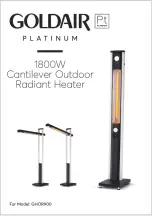
26
Page
Installation
Installation Manual
Cold
inlet
Hot
outlet
Gas
inlet
As Close as
Possible
Pressure
relief valve
WATER CONNECTIONS
5. There is a wire mesh filter within the cold inlet to
trap debris from entering your heater. This will need
to be cleaned periodically to maintain optimum flow.
(Refer to p. 56.)
All pipes, pipe fittings, valves and other components, including soldering materials, must be suitable for
potable water systems.
1. A manual shutoff valve must be installed on the cold water inlet to the water heater between the
main water supply line and the water heater.
2. In addition,
a manual shutoff valve
is also recommended on
the hot water outlet of the unit.
Isolation valves
are available.
3. If the water heater is installed within, or subjected to, a closed
loop water system,
a thermal expansion tank or a code approved
device to handle thermal expansion
must be installed.
Do not use this appliance if any part has been under water. Immediately contact a
qualified installer or service agency to replace a flooded water heater. Do not attempt
to repair the unit! It must be replaced!
WARNING
Do not reverse the hot outlet and cold inlet connections to the water heater. This will
prevent the water heater from activating properly.
NOTICE
4. Before installing the water heater, flush the water
line to remove all debris, and after installation is
complete, purge the air from the line. Failure to do
so may cause damage to the water heater.
-Pressure relief valve-
The water heater has a high-temperature shutoff switch built in as a standard safety feature (called a
Hi-Limit switch). Therefore, a
“pressure only”
relief valve is required.
•
This unit does not come with an approved pressure relief valve.
•
An approved pressure relief valve must be installed on the hot water outlet.
•
The pressure relief valve must conform to the current edition of
ANSI Z21.22
or
CAN 1-4.4
and instal-
lation must follow local codes.
•
The discharge capacity must be at least 140,000 BTU/h for the 110C model, 190,000 BTU/h for the
310C model, and 199,000 BTU/h for the 510C model.
•
The pressure relief valve must be rated for a maximum of 150 psi (1 MPa).
•
The discharge piping for the pressure relief valve must be directed so that the hot water cannot splash
outward and cause damage or personal injury.
•
Attach the discharge tube to the pressure relief valve and run the end of the tube to within 6 in.
(152 mm) from the floor. This discharge tube must allow free and complete drainage without any
restrictions.
•
If the pressure relief valve installed on the water heater discharges periodically, this may be due to a
defective thermal expansion tank or defective pressure relief valve.
•
The pressure relief valve must be manually operated periodically to check for correct operation.
•
No valve must be placed between the relief valve and the water heater.
WARNING
Hot water could be released when the pressure relief valve is opened. This
could result in severe personal injury. Contact with discharge may cause prop-
erty damage and/or bodily harm. Before operating the pressure relief valve
manually, check that it will discharge in a safe place. If water does not flow
freely from the end of the discharge pipe, turn the gas supply and power OFF
and call a qualified person to determine the cause.
Refer to the pressure relief valve manufacturer's instructions for inspection and
maintenance requirements.
















































